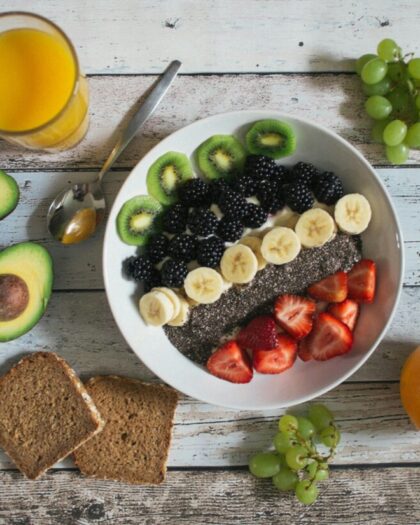
Carbohydrates, Protein, and Fat - the three macronutrients that make up all foods. Each of these macronutrients, as individuals, are important and beneficial in our diets for various reasons. But how much and which of these should we be prioritizing? There can be a lot of conflicting information out there that will make your head spin. In this post we will dive into each of these and their unique roles within our bodies and we will discuss why it’s essential that we include each in our diet.
Taylor Grasso, a Registered Dietitian, has a unique and captivating way of viewing the food we eat and our relationship with food. She promotes more emphasis on the nutrient-density of our meals versus focusing solely on the caloric-density. She also talks about incorporating, what she refers to as “The Power 4,” in our meals and snacks which we will review below.
Carbohydrates: The Fuel
Carbohydrates have been receiving a bad rap in recent years, often being the root of blame for weight gain or poor blood sugar control. But what if we told you that carbohydrates are not the villain? First, let us talk about what carbohydrates are and why we need them in our diets. There are three different types of carbohydrates: sugar, starch, and fiber, all of which are part of a healthy balanced diet. For most individuals, carbohydrates should make up 45-65% of our diets. They are our body and brain’s preferred source of fuel and when we consume these, they are broken down into their simplest form - glucose, which is then taken up by our body and used as quick fuel for providing the necessary energy our bodies need. The recommendations are to make at least half of your carbohydrates from whole grain sources (i.e. oats, whole grain bread) and to limit the amount of added sugars consumed. Carbohydrates, as well as the other two macronutrients, are not something to be feared and are quite the opposite - they are essential when consuming a balanced diet.
Protein: The Builders
Protein molecules have several important functions throughout our bodies, such as repairing our cells and tissues but also playing roles in hormone regulation and immunity (Duyff, 2017). When you consume protein, your body breaks this down slower and leads to us feeling more satiated, as well as maintaining that feeling of satiation between meals. When you consume carbohydrates with protein, your body breaks down the carbohydrates slower which leads to smaller and slower blood sugar changes throughout the day. Depending on your health and fitness goals, protein is an integral part in maintaining, or the building of your muscle mass.
Healthy Fats: The Essentials
Fats are another macronutrient that have been scrutinized and held under the microscope in society and the media in years past. Fats are the most nutrient-dense macronutrient, so they provide more calories per gram, which may cause some people to fear eating fats due to the caloric content of these foods that are provided in a smaller amount when compared to carbohydrates or protein. However, what we can also translate this to is that we still need to consume these foods in order to have a well-balanced diet, but just in appropriate portion-sized amounts.There are different kinds of fats, but we want to focus on consuming ones that contain more monounsaturated and polyunsaturated fats, and less of ones that contain saturated or trans fat. Consuming these ‘healthier’ fats are essential when incorporating a healthy balanced diet as they have many responsibilities which range from the absorption of essential fat-soluble vitamins: A, D, E, and K, to functions in our nervous system, as well as maintaining our cell structure and integrity (Duyff, 2021). Like protein, fats are a very satiating nutrient and, when consumed in moderation and within a balanced diet, are helpful with keeping you feeling full for a longer period of time.
Color: Adding Fun to Your Plate
We’ve all heard the term that we eat with our eyes first. When we consume foods, specifically fruits and vegetables of all different colors, we are eating more nutrient-dense foods that our bodies need. In addition to increasing that nutrient-density, we are also increasing our fiber intake. When we increase our fiber intake, just like protein and fat, we will feel more full and for a longer period of time. There are many other benefits to increasing our fiber intake as well, such as “[reducing] the risks for obesity, heart disease, type 2 diabetes, and other chronic diseases” (Duyff, 2021).
CONCLUSION
So how can we use our new knowledge to better help us meet our health and nutrition goals? When planning our meals, as Grasso points out in her videos, if we think of the meal in terms of nutrient-density vs caloric-density and adding to our plates vs removing, we will notice that we start cultivating a more healthful relationship with food, rather than placing foods on a pedestal of “good” or “bad.” When we are appropriately balancing out our food, we will likely find that we are feeling more energized, have better sleeping patterns, or you may even be able to finally reach those health and fitness goals you’ve been striving and working hard for.
If you’re interested in learning more about how your diet and nutrition can better help you reach your personal goals, visit with one of Total Balance’s Registered Dietitians!
Sources:
Duyff, Roberta L. Academy of Nutrition and Dietetics Complete Food & Nutrition Guide. Boston New York, Houghton Mifflin Harcourt, 2017.
Grasso, T. [@simplehealthrd]. (n.d.). [TikTokprofile]. TikTok. Retrieved May 10, 2024, from https://www.tiktok.com/@simplyhealthyrd?_t=8mEdKhAbIst&_r=1











